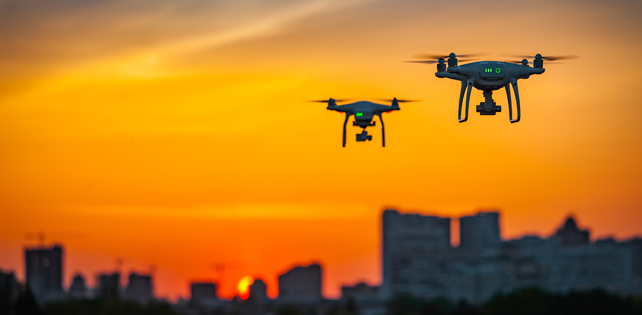
It was a very informative week at the FAA UAS Symposium 2019 in Baltimore, Maryland last week. There were three days of panel sessions on unmanned air systems, commonly known as drones, with global experts discussing a range of topics on unmanned aircraft systems traffic management (UTM), including beyond visual line-of-sight (BVLOS), detect-and-avoid (DAA), FAA certification strategies, safety, security, and risk reduction. These discussions prove that we are rapidly advancing the state-of-the art in UAS aircraft operations and incrementally expanding UAS windows of operations as technology and regulations evolve. One of the highlights of the meeting was that Amazon Prime Air received their first approval for testing drone deliveries.
But despite these UAS achievements, there are three fundamental challenges that need to be solved in order to vastly increase the utility of UAS platforms in commercial operations: scalability, safety and security.
1. Scalability. A more robust infrastructure needs to evolve to accommodate the predicted massive increase in uncontrolled and controlled UAS participants. This infrastructure cannot be static, nor patterned after reliable airline operations and manned private aircraft. It must be a highly dynamic system that can readily adapt and grow in strength and utility as more and more unscheduled and unpredictable future systems enter our shared airspace.
2. Safety. The FAA has stated that safety is its number one priority. Yet the FAA is quite aware that the challenge of managing safety in a mixed manned/unmanned airspace is an order of magnitude greater than what is managed today. Existing safety standards, proven by decades of reduced aircraft accidents, can be expanded for use with unmanned systems in properly implemented UAS safety use cases.
3. Security. Security is paramount with UAS systems. With new, smaller and harder-to-detect UAS platforms, it will become much more challenging to detect and manage threats and incidents. Beyond the federal agency control of security, the systems operators and end users must adhere to strict data security requirements.
These challenges have underscored the necessity for a different platform to run these new and mission-critical autonomous applications. They require a proven, loosely coupled, standards-based, open communications platform to be the foundation of their success.
Data Distribution Service™ (DDS) is the proven standard that is widely used in distributed, unpredictable and mission-critical environments. It is particularly suited for highly scalable, high-security environments such as UAS.
DDS solves the scalability challenge.
Traditional point-to-point, server-based architectures cannot support rapid integration of new platforms that enter and leave the airspace without advance warning. They cannot scale from a single safety use case to a wide range of devices running on multiple, undefined data sources. RTI Connext® DDS, based on the open DDS standard, provides a loosely coupled architecture plus discovery mechanisms that allow the instantaneous creation of new peer-to-peer networks that can provide highly efficient, real-time information exchange for a wide variety of use cases, including UAS.
Safety is paramount in the skies.
The number one concern for the FAA in expanding operations of new aircraft types is safety. Thousands of hours could be invested to prove a safety use case for a particular UAS in a particular commercial delivery system. However, it is far more efficient to follow the lead of successful commercial aircraft manufacturers and use proven aircraft and system certification strategies and existing safety standards. This software requires RTCA DO-178C compatibility, which has an outstanding record of safety and has a rich ecosystem of service firms that can support any type of software certification. RTI Connext DDS takes this one step above the rest with its commercial-off-the-shelf (COTS) RTCA DO-178C DAL A, the highest criticality design assurance level for software available.
Security is the toughest challenge in the skies.
In today’s highly connected world with entrenched gangs of malicious actors – and new ones surfacing daily – security is the toughest challenge to address. As we move from simple, single use case UAS operations to highly networked, ever-changing and dynamic operations in densely populated areas, the competitive differentiator will be ever-vigilant, highly-adaptable security that defines commercial UAS value and utility. Future UAS platforms and systems must grow beyond static safety and security use cases into robust defenders of the delivery channel, evading a constant barrage of threats that are yet to be defined. Today’s ground delivery vehicles are moving safety deposit boxes, with metal enclosures coupled with locking mechanisms. Tomorrow’s airborne delivery systems will be relatively lightweight, unprotected platforms that must navigate around menacing threats to securely deposit their packages into protected repositories of material.
Creating a viable autonomous vehicle delivery system capable of transporting both people and packages across the globe through a safe, secure and reliable service will be a monumental effort, similar to the buildout of today’s commercial airline system that took decades. This infrastructure must be built upon trusted technology building blocks. It must be built to last to protect the future generations of businesses that will depend upon its reliable, safe and secure operations for the expansion of their goods and services.
For this, it’s time to turn to the trusted platform that has been proven across autonomous platforms, Connext DDS, to keep the air space – and the manned and unmanned systems that use it – safe and secure now and in the future.
About the author

Chip Downing is the Senior Market Development Director of Aerospace and Defense at RTI, where he manages the global aerospace and defense business and helps drive the OMG® DDS industry standard and the market-leading RTI Connext DDS platform into the commercial and military aerospace market.
Mr. Downing currently serves as the VP, Ecosystem of the DDS Foundation, where he is tasked with growing the sphere of influence of the OMG DDS standard with organizations that have companion specifications. In addition, he also serves as the Chair of the FACE Consortium BWG Outreach Subcommittee, promoting the FACE approach globally.
A veteran of the embedded systems industry and an innovator for creating COTS safety certification for commercial RTOSs, he previously served as Senior Director of Aerospace & Defense at Wind River Systems, where he was responsible for the business development of the company’s global A&D markets. During his 14-year Wind River tenure, design wins grew for certified avionics products grew to more than 500 projects. Mr. Downing has also led sales, marketing, and consulting organizations at Esterel Technologies (now Ansys), Validated Software, OnCore Systems and Mentor Graphics (now Siemens).
Posts by Tag
- Developers/Engineer (177)
- Connext DDS Suite (77)
- Technology (74)
- News & Events (73)
- 2020 (54)
- Standards & Consortia (51)
- Aerospace & Defense (48)
- Automotive (35)
- 2023 (34)
- 2022 (29)
- IIoT (27)
- Leadership (24)
- 2024 (22)
- Cybersecurity (20)
- Healthcare (20)
- 2021 (19)
- Connectivity Technology (16)
- Military Avionics (15)
- Culture & Careers (14)
- FACE (13)
- Connext DDS Pro (10)
- JADC2 (10)
- ROS 2 (10)
- 2025 (8)
- Connext DDS Tools (7)
- Connext DDS Micro (6)
- Databus (6)
- Transportation (5)
- Case + Code (4)
- Connext DDS (4)
- Connext DDS Cert (4)
- Energy Systems (4)
- FACE Technical Standard (4)
- Oil & Gas (3)
- RTI Labs (3)
- Research (3)
- Robotics (3)
- #A&D (2)
- Connext Conference (2)
- Edge Computing (2)
- MDO (2)
- MS&T (2)
- TSN (2)
- ABMS (1)
- C4ISR (1)
- ISO 26262 (1)
- L3Harris (1)
- LabView (1)
- MathWorks (1)
- National Instruments (1)
- Simulation (1)
- Tech Talks (1)
- UAM (1)
- Videos (1)
- eVTOL (1)
 Success-Plan Services
Success-Plan Services Chip Downing
Chip Downing